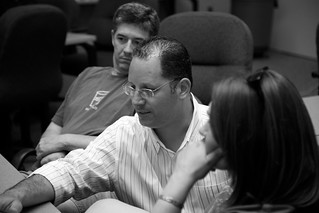D'Arcy said a switch got thrown in his head. Watch his video of the results; as you watch you'll get a sense of what his year was like, when and where he went on vacation, his love for his son, the things he finds interesting, but pay particular attention to how he uses perspective, how sets up his "shots", and the things in his world he notices:
As the new year rang in for 2008 several other people in my aggregator decided to join D'Arcy in his new experiment: 366 Photos (2008 is a leap year). After several weeks many started writing about how their visual perception changed as a result of doing this. They started noticing things they hadn't before, the quality of the photos they took (of things, family, friends, events, etc.) improved dramatically, and a switch in their heads flickred.
 I came late to this party for a number of reasons, not the least of which is that the "every day for a year" commitment intimidates me. So, in March I started my own experiment: 31 Days.
I came late to this party for a number of reasons, not the least of which is that the "every day for a year" commitment intimidates me. So, in March I started my own experiment: 31 Days.
There's a bit of folk wisdom that says it variously takes 21 or 28 days to create (or break) a habit. (15 minutes a day every day. If you miss a day just keep going until you get to 21 — or 28 — days in a row.) I've been able to find no verifiable research to back this up so make of it what you will. In any case, I did find that my 31 Days experiment lead to a change in the way I see the world and use visual imagery in my teaching.
 Now, this part wasn't planned, but as I've used flickr more and more I've become more and more interested in taking "interesting" pictures.
Now, this part wasn't planned, but as I've used flickr more and more I've become more and more interested in taking "interesting" pictures.
As a math teacher I was fascinated to discover that photographers have long known of and used a mathematical definition for beauty. It's based on the number φ, phi (one H of a lot cooler than π, as my students say), which it turns out is embedded in the the natural world in all sorts of ways including the various dimensions of our own bodies. I digress, that's a post for another time. ;-)
I stumbled upon an online photography course over at morgueFile.com. I've only read through Lesson 1: Composition And Impact - It's A Beautiful Photograph, But Do You Know WHY It's Beautiful?. It had a significant impact on how I take pictures and view the world. That was almost a year ago. I'm about ready to move on to Lesson 2: Aperture And Shutter Speed - How They Work Together.
Here's how I did my 31 Days experiment:
» All pictures were taken with my cell phone. (Because it's always there, and it's easy.)» All pictures were uploaded to flickr (almost) daily. (You can send directly from your phone if you like.)
» All pictures were tagged with a unique tag for the experiment. i.e. 31Days.
» All pictures were aggregated on my blog using a slideshow tool, SlideFlickr.com (also allows you to embed music).
» I took at least one picture every day. (Some days I took more and picked the one liked best.)
You might wonder: Why all this photography stuff from a math teacher? Well, the short answer is that I wanted to model what I asked my students to do — check out the flickr assignment I designed.
The long answer is: It has enriched my life. I used to leave taking pictures to others; my wife or mother-in-law. Now I take more pictures than anyone, and the skills I've developed have lead to some striking pictures of my kids (sorry, we don't publish publics pics of our kids online ... yet). More than that, it has effected the way I read to learn. I recently finished reading John Dewey's Experience and Education. I decided, as a mnemonic and a way to help me move everything I read into long term memory swiftly, I would mentally construct an image that summarizes the content of each chapter. I hope to publish it as a slidecast (slideshow + podcast) on Slideshare in the near future. I know that little book really well as a result of doing this. Creating the slidecast will really embed it in my brain.
Anyway, I think I'm ready to try this experiment again in October. October in Winnipeg starts with colourful leaves on the trees and ends with snow on the ground. This is going to be fun!
- 9/22/2008 04:22:00 pm
- 9 Comments




